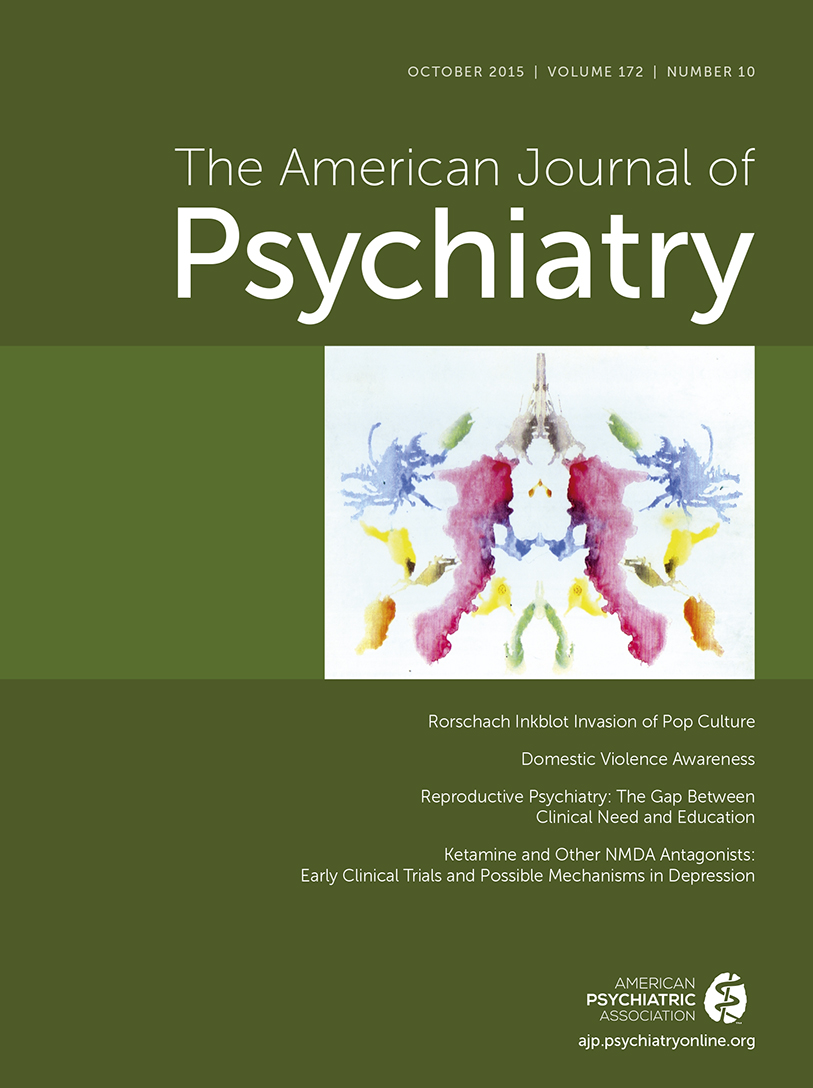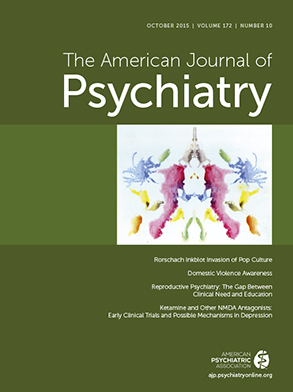The onset of schizophrenia is usually characterized by a prodrome in which nonspecific symptoms such as depression and anxiety, followed by subthreshold “attenuated” psychotic symptoms, precede the onset of characteristic positive symptoms (
1). Observations of this sequence led many clinicians and researchers to query whether this prodromal phase could be detected and treated, leading to possible prevention of schizophrenia (
2), and criteria were developed to detect the prodrome more than 20 years ago. The criteria, which are applied to help-seeking adolescents and young adults, require the presence of at least one of the following: attenuated psychotic symptoms; brief, limited intermittent psychotic symptoms (a brief period of full-blown psychotic symptoms that resolve without treatment); or a trait risk factor (schizotypal personality disorder or having a first-degree relative with a psychotic disorder) combined with a marked decrease in functioning. Because not all people who are deemed “prodromal” develop a psychotic disorder, the criteria are termed “high risk,” “ultra high risk,” or “clinical high risk” (
3,
4). This terminology recognizes that a “prodrome” can only be identified retrospectively, once a syndromal disorder has begun.
The high-risk concept has been used in several studies, and clinical services for high-risk individuals have developed worldwide. High-risk individuals are symptomatic and often meet the criteria for mood, anxiety, and substance use disorders at baseline (
5). They display functional, neurocognitive, and social-cognitive deficits at a level between those of healthy subjects and first-episode psychosis patients (
6,
7). As hypothesized, they have a high risk of developing a first episode of psychosis within a short period. A recent meta-analysis showed a “conversion” rate of 36% after 3 years (
8). Thus, not only does identification of the high-risk group open up the opportunity for early intervention, it also enables the study of disease mechanisms.
However, the challenge of false positives (those identified as high-risk who do not develop a psychotic disorder) remains. Several groups have attempted to identify predictors of psychosis within the high-risk group. Yet, despite findings of risk factors for psychosis within this group that could enable better identification of those at greatest risk of developing a psychotic disorder, the high-risk criteria have not changed substantially since their introduction in 1994. This is mainly because findings are often not replicated, possibly because of differences in measures, age ranges, referral patterns, and interventions. Furthermore, there has been an assumption that the three high-risk groups carry the same risk, so that factors that appear to be significant predictors in one high-risk population may not be so in another.
In this issue, Cornblatt et al. (
9) acknowledge these issues and move the field forward. They examined a homogeneous high-risk group by confining their sample to individuals who met the attenuated psychotic symptoms criteria. Based on the neurodevelopmental theory of schizophrenia, they also used “vulnerability indicators,” including cognitive deficits and social and role difficulties. The authors’ theory-driven approach, together with a large sample (N=101) recruited from a single site, a reasonably long follow-up period (a mean of 3 years), and a low attrition rate, are strengths of the study. The age range was 12–22 years.
The authors found that 19.4% of their group developed a psychotic disorder within 4 years; an additional conversion at 6 years brought the cumulative rate to 28.3%. Predictors of development of psychosis were disorganized communication, high suspiciousness level, verbal memory deficits, and declining social functioning. Young age at baseline (12–14 years) was associated with nonconversion. That is, no individual in this age range at baseline developed a psychotic disorder over the follow-up period.
Cornblatt et al. then combined their predictive variables into a model that had a sensitivity of 60%, a specificity of 97.4%, and a positive predictive value of 81.8% for psychosis. In other words, a high-risk individual in this sample who had disorganized communication, high levels of suspiciousness, and poor verbal memory and social functioning at baseline had nearly an 82% chance of developing a psychotic disorder within a relatively brief time frame (up to 6 years). This is an advance on the modest predictive power of the current high-risk criteria on their own.
The authors then used their model to generate a “prognostic score” for each high-risk individual according to whether the person displayed the baseline risk factor and weighted by the hazard function of each predictor. This was done for each predictor, and a prognostic score was generated for each person. This score was then compared with what actually happened (whether the person developed psychosis or not) to test the validity of the model. The authors found that individuals with high prognostic scores had high rates of psychosis development and that those with low scores had low rates. However, those with intermediate scores had inconsistent outcomes. As Cornblatt et al. discuss, these findings suggest some clinical utility of the prognostic scores at an individual level. Thus, individuals with high prognostic scores on entering the service should be vigilantly monitored and treated, perhaps with medication, while those with low scores would require minimal monitoring and intervention. However, the model is less useful for individuals with intermediate scores.
These findings need replication in independent high-risk samples. Any change in the high-risk criteria will need to take into account the priority of specificity over sensitivity or vice versa, as this will depend on the purpose of the criteria used. If the aim is to test etiological models of schizophrenia and examine the trajectory and progression of, for example, structural brain changes, then a sample with high specificity would be needed, with high rates of psychosis development, even if some individuals genuinely at risk were missed. In contrast, if the aim is to provide a clinical service for symptomatic young people at risk of psychosis who would not otherwise be able to get help, then sensitivity may be more important than specificity. This would ensure that the majority of people at risk were identified and monitored, even if some not truly at risk were in the service. The age range of services may also need consideration given the low risk among individuals in the 12–14 age range.
An important caveat noted by the authors is that the predictors from this study should not be applied to the general population. The predictive accuracy of any high-risk criteria depends on the base rate of psychosis in the group sampled. The high-risk group studied to date consists of help-seeking young people who have been referred to clinical services. They therefore would be expected to have a higher risk of psychosis than people in the general population. Applying the high-risk criteria to a general community sample would yield much lower rates of development of psychosis.
One limitation of the study is that it focuses only on transition to psychosis as the outcome of interest. Recently, functional impairment (
10) and persistence of attenuated positive symptoms have been seen as other important outcomes in this group (
11).
Nonetheless, Cornblatt et al. have made a major contribution to the field. Verbal memory deficits in particular should be combined with clinical risk factors in future studies and predictive power assessed. Cornblatt et al. have also provided researchers with a method of stratifying levels of risk within the high-risk group. This approach can be used to guide management and moves us closer to enabling more personalized treatment of high-risk young people.

